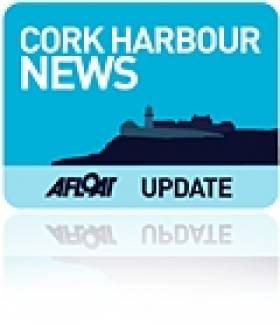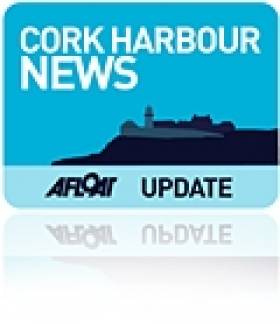Displaying items by tag: Cork Dockyard Gathering
Naval Vessel Tours, An Example of Verolme Cork Dockyard Built Ship
#VerolmeWeekend – The Naval Service OPV L.E. Aoife (P22) which this week detained a UK registered trawler, is to be open for public tours at Cobh Deepwater Quay, as part of Cork Dockyard Workers Gathering this weekend, writes Jehan Ashmore.
Tours (2-5pm) of the Verolme Cork Dockyard built vessel commissioned in 1979 will provide access to view the second of the trio of 'Emer' offshore patrol vessels.
The leadship of this class L.E. Emer (P21) completed in 1978, is to perform her final patrol next month. As previously reported on Afloat.ie she is to be put up for public auction, if not previously sold, in late September 2013 and LE Aoife is to follow suit a year later.
The L.E. Emer and her sisters are a derivative of L.E. Deirdre (P20) and which saw the trio of OPV's modified to improve stability and increased speed. The 'Emer' class were also fitted with a bow thruster to improve manoeuvrability especially in confined waters. Noting, the 'Deirdre's bow which has a more pronounced flare compared to her newer sisters.
L.E. Deirdre was the first custom-built vessel commissioned for the Naval Service when she was launched in 1972. She was decommissioned in 2001 and sold for €190,000. She was then converted into a luxury private yacht, Santa Maria, for more details visit this Facebook page.
Of the remaining trio, L.E.Aisling (P23) dating from 1980 is the youngest. She will be retained when the pair of OPV's which are been built by Babcock Marine, Appledore in north Devon enter service in 2014 and 2015 to replace L.E. Emer and L.E. Aoife.
The newbuilds are to break with tradition as reported in that they will be named after male literary figures (L.E. Samuel Beckett and L.E. James Joyce) rather than female mythical figures.
When these newbuilds enter service they will maintain the eight-strong fleet which includes the 'flagship' L.E. Eithne (P31).
As reported earlier today, she represents the last vessel commissioned for the navy by VCD and indeed is the final ship ever to be launched from the shipyard in Rushbrooke in 1984.
During its quarter century existence, VCD built a total of 33 vessels, mostly for Irish concerns, among them Irish Shipping Ltd, B+I Line, Arklow Shipping and a handful of overseas clients to include Sealink / British Rails' 'Freightliner' division.
Cork Dockyard Gathering Weekend: Lecture Seminar Programme
#VerolmeWeekend – As part of the Cork Dockyard Gathering Weekend as previously reported, a lecture seminar is to be held in Cobh's Commodore Hotel this Saturday 24 August.
Former employees of Verolme Cork Dockyard (VCD) in Rushbrooke, Cobh and their families and the public are being invited to take a trip down memory lane to celebrate 150 years of the glory days shipbuilding and repair. For a list of shipping related lectures at the seminar, see below.
At its peak VCD employed over 1200 personnel and closed in 1984 with the last ship built at the yard the L.E. Eithne (P31) completed for the Naval Service. The site currently maintains a ship repair business operated by Cobh Dockyard.
As reported earlier, at the official opening of the Cork Dockyard photograph exhibition in Cobh, Captain Michael McCarthy Commercial Manager Port of Cork commented that he believed that Cork Dockyard has a potentially vibrant future particularly in the offshore oil and gas support role, offshore wind energy and wave and tidal.
He said: "Although it may never return to its former glory days in shipbuilding, I can see its potential in employment for our young people and training prospects. It is still one of the most unique facilities in the country and when we see how Harland and Wolfe capitalised on their asset, it is very important that we keep an open mind on its undoubted potential."
Tomorrow morning an opening ceremony of the Cork Dockyard Weekend will be held at 11 am on Cobh's Promenade. This will be followed by the lecture seminar (1-6pm) hosted in the Cobh waterfront hotel's Jack Doyle Room. Below is a listing and times of the FREE lectures.
13.00hrs: The History of the Irish Navy Service - Cmdr. Steve Walsh, Operations Command, Naval Base, Haulbowline.
14.00hrs: Irish Shipping Ltd: The First Fifteen Ships – Rosslare Maritime Enthusiasts
15.45hrs: Tea-Break
16.00hrs: Launching of a Ship - John Brennan
16.40hrs: Heavy Lifting Platforms - Capt. Pat Murphy, Port of Cork
17.20hrs: History of Port of Cork - Capt. Pat Farnan.
18.00hrs: Close
Immediately after the lectures on the Saturday there will be an informal social evening in the Commodore Hotel, commencing with a performance by local sea shanty group Molgoggers.
For further details of other events organised throughout the weekend, visit this previous report.






























































